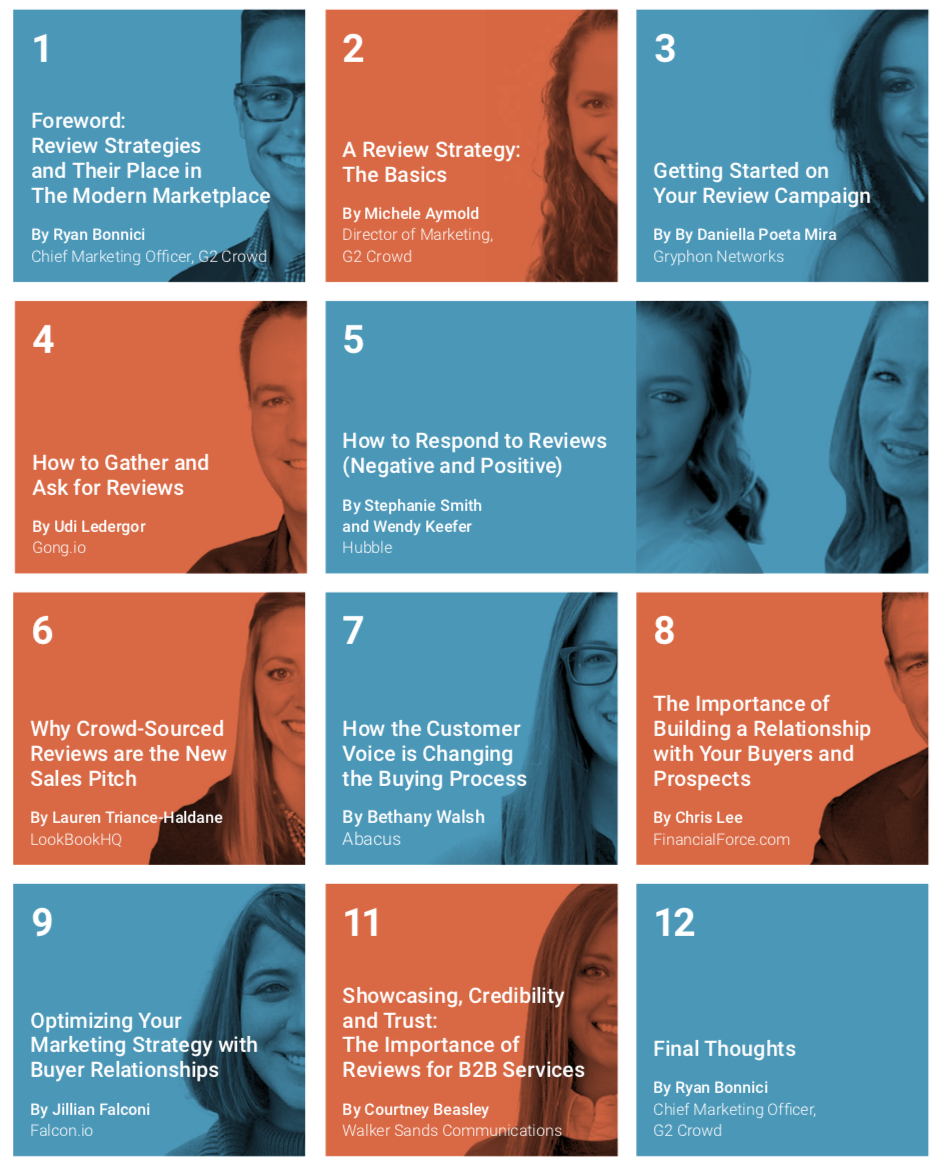

NEWS FLASH: Content marketing is trendy. Like really trendy.
In fact, it’s so in right now that 84 percent of people expect brands to provide content that entertains, tells stories, and provides solutions.
Well, luckily, I’m here to help you master one type of content that does all of those things: An eBook!
What is an eBook exactly? This article will cover the basics and give you a step-by-step walkthrough on how to create and make a marketing eBook from start to finish. I’ll also give you some of my favorite examples and tips to make this process as easy as possible for you.
Now let’s do this.
Creating an eBook may seem like a tough project, but by following these 10 steps you'll make your first eBook in no time.
Before you begin any planning, consider the objective of your eBook. In other words, understand what business goal you’re solving and determine how to solve it.
Are you looking for lead generation? Make the eBook gated so that you can gather email addresses. Trying to increase brand awareness? Position your brand as a thought leader on the subject. Whatever the goal is, be prepared to design an eBook that helps you achieve this goal.
When choosing a topic for your eBook, the first thing that should cross your mind is your audience. With countless possible topics for you to write about, it’s easy to settle on a topic that interests you, but that doesn’t necessarily mean it interests your audience.
Choosing a topic that’s unrelatable will set you up for failure from the start. So take a moment to stop and consider who your audience is. What do they want to know more about? What do they need to know more about? The key is to know what they’re looking for. Can you identify their problems and possible solutions for them? Answering questions like these will help you narrow down potential eBook topics that will really pull your audience in.
Another thing to keep in mind: be knowledgeable on the topic. Yes, it’s important to choose a topic that interests your audience, but if you decide to take a deep dive on a topic that you don’t actually know much about, your credibility goes out the window.
The more specific your title, the better. Your title should give readers a clear understanding of what your eBook will cover. Having a vague title gives your readers no reason to read your eBook. If they don’t know what they’ll gain from reading, they won’t waste their time.
So let’s discuss what makes an effective title.
Take one of our eBooks for example:
When you read this title, do you have a clear understanding what the article is going to cover? Yes. Just by reading a few words, you know that you’ll learn how to build an effective review strategy, and get tips, best practices, and success stories from high-level marketers too. It’s specific and there’s no confusion of what the eBook will cover.
You’ll catch me writing without an outline when pigs fly (aka: never). I consider outlining an essential part of the writing process, especially with informative content. Your goal is to fix the readers’ problems; so make it easy on them with well-organized, easy-to-read content.
Before you begin writing, create an outline of your eBook. It will not only save you time in the long run, but it'll also streamline the writing process along the way.
Your outline should include the following:
Let’s take a deeper dive into each section.
I personally write the introduction last. Why? Because throughout the writing process, I gain clarity on my audience, topic, goals, and how they all fit together. I see the big picture. This is exactly what you want your introduction to be: an overview of the big picture.
Your job here is to not just draw the reader in, but explain to them why and how your eBook will help them. Give them a look at the big picture. Highlight their pain points and give them reason to believe that reading your eBook will give them the answers they’ve been looking for.
You’ll want to keep your eBook organized and easy to follow, so break it into chapters. To do this, consider the main points you want to cover throughout your eBook.
Say you’re giving your readers a crash course on the subject you’ve chosen for your eBook. What are the overall points you want to get across? These are your chapters.
For example, in our eBook on building an effective review strategy, we created chapters for each point we wanted to elaborate on.

Once you’ve outlined your chapters, divide each chapter into smaller bullet points or sections. This will allow you to clearly communicate each separate idea within the chapter and ensure that you discuss every point you want to convey.
With your eBook being an important part of your inbound marketing strategy, you’ll want to make sure that visitors aren’t just reading your eBook, but taking further action with it. How do you do this? Optimize your content with CTAs.
Plan to place appropriate calls-to-action within your content, getting readers to further engage with your company. Your CTAs should be simple and actionable. Tell the reader exactly what you want them to do.
Some examples of common calls-to-action include:
Here are a few CTAs we personally have used to encourage readers to engage with G2 Crowd further.

Now it’s time to write! Finally. With a plan of attack and a detailed outline, this should be fairly easy and fun.
The outline should have made the organization of your ideas logical and easy to follow. So from there, expand your ideas. Add details, let your creative juices flow, and get your write on.
When it comes to writing, everyone has a different process. Whether you work from start to finish or bounce from chapter to chapter, use the process that works for you. All that matters is that you’re clearly communicating your thoughts and bringing readers the solutions they need.
A few things to keep in mind:
Related: Research eBooks from other companies in your industry to gain inspiration for your eBook. Here is a great guide to creating a successful eBook.
|
Tip: Looking for software to help you create your eBook? Check out the best document creation software here! |
When it comes to proofreading, you’ll want your eBook to go through a minimum of two, but up to four, rounds of edits. Getting fresh pair of eyes on your eBook is crucial because it allows you to catch mistakes, get additional insight on your thoughts, and utilize feedback to better your eBook.
Failing to proofread can make the difference between a subpar eBook and an eBook that’s well-polished. If you want to be a source that people trust, don’t skimp on the proofreading.
| Tip: Don’t proofread your eBook yourself. Writers often become so familiar with their own content that they overlook errors that will be obvious to someone else. If you can hire a professional editor or have a few qualified friends look it over, they’ll be more likely to catch mistakes that you missed. |
Visuals can add value to your writing in a couple of ways.
One, breaking up large blocks of text with images or graphs makes an article easier on readers’ eyes. It becomes less overwhelming and easier to scroll through.
Two, visuals complement the material you’re covering while enhancing the readers’ understanding of the material. Images, graphs, and infographics are great ways to illustrate ideas that might be hard to convey solely in words.
All in all, building in valuable visuals throughout your eBook will greatly improve every reader’s experience.
Tip: Infographics are great for quick facts and easily shareable on social media. Consider including them to illustrate important points in your eBook.
Here’s an example of a graphic we used in a recent eBook. Quick, easy facts!
You’ve spent time writing the eBook, now it’s time to think about the design.
Below I’ll cover important criteria to consider when designing your eBook.
If you’re fortunate enough to have an in-house graphic design team or one readily available, use them! Prepare a creative brief with the following information for your designer so they have a clear understanding of your vision.
If you’re designing the eBook yourself, have no fear, let me walk you through it.
Long form content is anything but welcoming. If you’re like me, you take a quick scroll through the article to see if it’s worth your time. Looks tedious? Then it’s a no from me. If you want your reader to even consider actually reading your eBook, you need to format it in a way that’s not overwhelming.
To do this, use formatting to create digestible and scannable content. Use lists, breaks, and a lot of paragraphs so your content is easy and enjoyable to read.
Your eBook should be fun and colorful, but be sure not to get too carried away, it should still match your brand. Keep your eBook colors consistent with your brand’s palette. This will make for a fun yet professional eBook.
There are hundreds of cool fonts to choose from, maybe even thousands. I’m sorry to burst your bubble, but when it comes to your eBook, stick to the basics. The last thing you want is unreadable content. Use a plain jane, easy-to-read font in a legible size. And when determining the type and size of your font, take into consideration what device your audience is likely to read it on.
Also consider bold text, italics, and font size changes to draw readers to content that you want to emphasize.
It’s your eBook, so include your brand. You don’t need to necessarily plaster your logo everywhere in the eBook, but consider using a small amount of branding on each page (i.e. a small logo in a corner). That way, if snippets of your eBook get used by someone without proper reference, those pages will still have your logo on them, and let any viewers know it’s your content.
Example: At G2 Crowd, we place our logo in the footer of each page of our eBooks. It’s simple, yet effective.

Tip: Think about the end user. If your eBook is primarily going to be something your audience will use on a desktop, consider landscape vs. portrait orientation. If there are a lot of worksheet aspects to your eBook, then your audience may want to print it. In that case, maybe don’t use floods of color and keep it printer friendly.
Once you’ve completed the writing and design of your eBook and looked over it one last time, it’s time to export the eBook as a PDF. This is the simplest way to publish your eBook. It’s an easy step to overlook, but extremely important that you don’t.
Exporting your eBook as a PDF will ensure that your content and format goes unedited by other users. If you fail to convert an editable document, your content can be distorted or misused by visitors.
Tip: For first timers I’d recommend exporting your eBook as a PDF simply because you have control over the look of the final document. If PDF doesn't work for you, there are several eBook formats to choose from.
You’ve put a lot of time into writing, editing, and designing your eBook, but promoting is equally as important, if not more. Without promotion, no one will read, or even see, your eBook.
Let me touch on a few simple ways to start promoting your eBook today.
Creating a landing page for your eBook is an easy way to turn visitors into business leads for your company. This page promotes your eBook and includes a form for visitors to fill out with their contact details if they want to gain access to your eBook. Once you have their information, your team can follow up with them. There are plenty of great landing page builders that can help you create the perfect landing page.
Tip: Try advertising your eBook on your website homepage with a link to it’s landing page.
Social media is a fast and easy way to promote your eBook.
Tweet tips and quotes from your eBook, share an infographic with highlights of your eBook on Facebook or Instagram, post Snapchat or Instagram stories with snippets of your eBook to create curiosity. The possibilities are endless with social media marketing. So be creative and schedule regular posts to spark interest in your eBook. Be sure to provide a link to your eBook in these posts so viewers can easily access it.
Tip: Create social media share buttons within your eBook to encourage readers to share on their personal social media profiles.
Incorporate your eBook in your blogging strategy. This means writing articles on the same, or similar, topics and linking back to your eBook in pertinent content. The ultimate goal here is to create content on your own and other sites that drives people back to your eBook. Understanding your blog strategy and how your website, content, and eBook work together will drive relevant traffic.
You can also create CTAs in relevant blog posts to encourage readers to check out your eBook and learn more about the subject.
Tip: Don't be afraid to go big or go home. The tactics above are common moves for promoting eBooks. If you’re looking to catch eyes, here are a few other promotional tactics to check out that will help your eBook get noticed.
There you have it! You now have the tools to successfully create an eBook. I know the thought of it was overwhelming at first. But with these easy steps and helpful tips, you’ll not only have an eBook in no time, you’ll have an eBook that's engaging, sparks conversation, and totally rocks.
Want more insight on creating eBooks? We asked 15 marketing experts for their best-kept eBook tips and best practices.
Jordan Wahl is a former content manager at G2. She holds a BBA in Marketing from the University of Wisconsin-Whitewater. She loves anything that puts her in her creative space. including writing, art, and music.
So if I’m guessing correctly, you’re here because you’ve decided to learn how to make an...
 by Jordan Wahl
by Jordan Wahl
Even if you create the best products in the world, your e-commerce store will fail if you...
 by Mitt Ray
by Mitt Ray
So if I’m guessing correctly, you’re here because you’ve decided to learn how to make an...
 by Jordan Wahl
by Jordan Wahl
Even if you create the best products in the world, your e-commerce store will fail if you...
 by Mitt Ray
by Mitt Ray
Never miss a post.
Subscribe to keep your fingers on the tech pulse.



